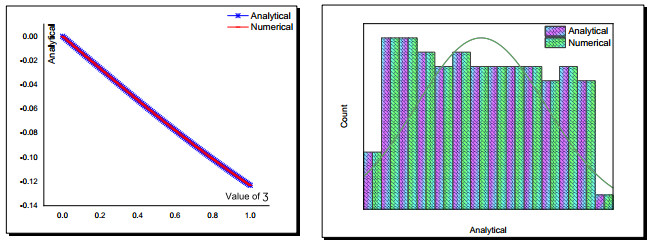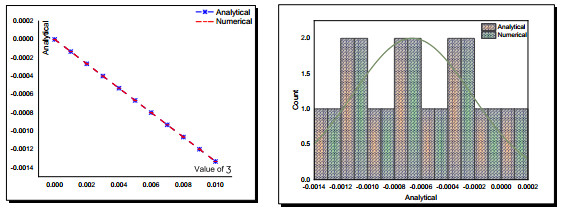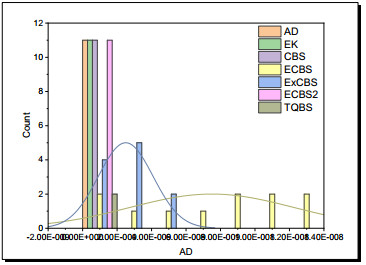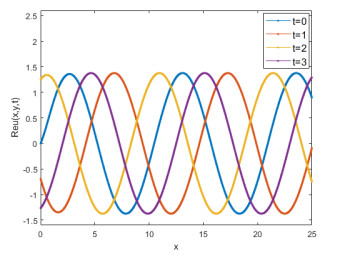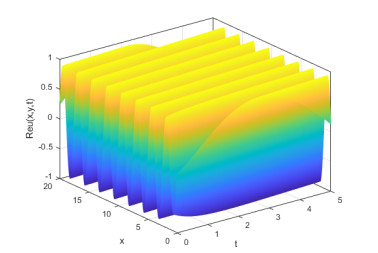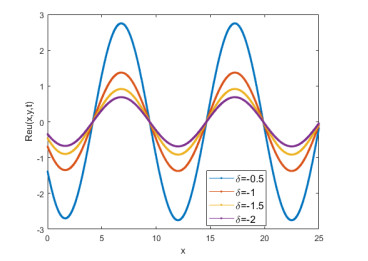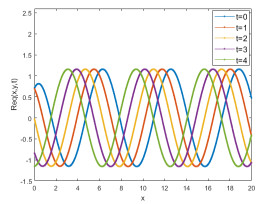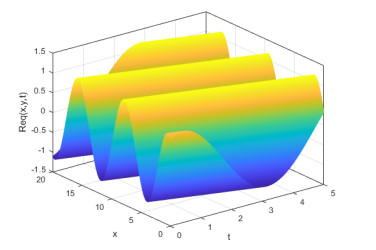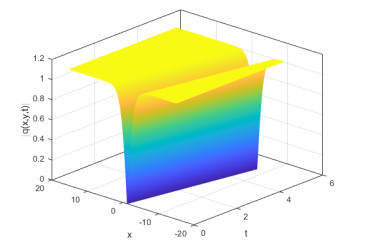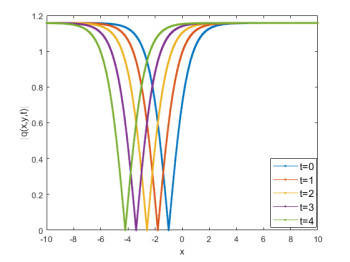|
[1]
|
H. Zhang, X. Yang, Q. Tang, D. Xu, A robust error analysis of the OSC method for a multi-term fourth-order sub-diffusion equation, Comput. Math. Appl., 109 (2022), 180–190. https://doi.org/10.1016/j.camwa.2022.01.007 doi: 10.1016/j.camwa.2022.01.007

|
|
[2]
|
X. Yang, H. Zhang, J. Tang, The OSC solver for the fourth-order sub-diffusion equation with weakly singular solutions, Comput. Math. Appl., 82 (2021), 1–12. https://doi.org/10.1016/j.camwa.2020.11.015 doi: 10.1016/j.camwa.2020.11.015

|
|
[3]
|
H. Zhang, X. Yang, D. Xu, Unconditional convergence of linearized orthogonal spline collocation algorithm for semilinear subdiffusion equation with nonsmooth solution, Numer. Meth. Part. Differ. Equ., 37 (2021), 1361–1373. https://doi.org/10.1002/num.22583 doi: 10.1002/num.22583

|
|
[4]
|
A. F. Daghistani, A. M. T. Abd El-Bar, A. M. Gemeay, M. A. E. Abdelrahman, S. Z. Hassan, A hyperbolic secant-squared distribution via the nonlinear evolution equation and its application, Mathematics, 11 (2023), 4270. https://doi.org/10.3390/math11204270 doi: 10.3390/math11204270

|
|
[5]
|
M. A. E. Abdelrahman, G. Alshreef, Closed-form solutions to the new coupled Konno–Oono equation and the Kaup-Newell model equation in magnetic field with novel statistic application, Eur. Phys. J. Plus, 136 (2021), 455. https://doi.org/10.1140/epjp/s13360-021-01472-2 doi: 10.1140/epjp/s13360-021-01472-2

|
|
[6]
|
Y. Cheng, A. Chertock, M. Herty, A. Kurganov, T. Wu, A new approach for designing moving-water equilibria preserving schemes for the shallow water equations, J. Sci. Comput., 80 (2019), 538–554. https://doi.org/10.1007/s10915-019-00947-w doi: 10.1007/s10915-019-00947-w

|
|
[7]
|
P. Ripa, Conservation laws for primitive equations models with inhomogeneous layers, Geophys. Astrophys. Fluid Dynam., 70 (1993), 85–111. https://doi.org/10.1080/03091929308203588 doi: 10.1080/03091929308203588

|
|
[8]
|
G. Laibe, D. J. Price, Dusty gas with one fluid, Mon. Not. R. Astron. Soc., 440 (2014), 2136–2146. https://doi.org/10.1093/mnras/stu355 doi: 10.1093/mnras/stu355

|
|
[9]
|
Y. Shi, X. Yang, A time two-grid difference method for nonlinear generalized viscous Burgers' equation, J. Math. Chem., 62 (2024), 1323–1356. https://doi.org/10.1007/s10910-024-01592-x doi: 10.1007/s10910-024-01592-x

|
|
[10]
|
C. Li, H. Zhang, X. Yang, A new nonlinear compact difference scheme for a fourth-order nonlinear Burgers type equation with a weakly singular kernel, J. Appl. Math. Comput., 70 (2024), 2045–2077. https://doi.org/10.1007/s12190-024-02039-x doi: 10.1007/s12190-024-02039-x

|
|
[11]
|
H. Zhang, X. Yang, Y. Liu, Y. Liu, An extrapolated CN-WSGD OSC method for a nonlinear time fractional reaction-diffusion equation, Appl. Numer. Math., 157 (2020), 619–633. https://doi.org/10.1016/j.apnum.2020.07.017 doi: 10.1016/j.apnum.2020.07.017

|
|
[12]
|
H. Zhang, X. Yang, D. Xu, An efficient spline collocation method for a nonlinear fourth-order reaction subdiffusion equation, J. Sci. Comput., 85 (2020), 7. https://doi.org/10.1007/s10915-020-01308-8 doi: 10.1007/s10915-020-01308-8

|
|
[13]
|
X. Yang, H. Zhang, Q. Tang, A spline collocation method for a fractional mobile–immobile equation with variable coefficients, Comput. Appl. Math., 39 (2020), 34. https://doi.org/10.1007/s40314-019-1013-3 doi: 10.1007/s40314-019-1013-3

|
|
[14]
|
H.S. Alayachi, The modulations of higher order solitonic pressure and energy of fluid filled elastic tubes, AIP Adv., 13 (2023), 115214. https://doi.org/10.1063/5.0179155 doi: 10.1063/5.0179155

|
|
[15]
|
X. Yang, W. Qiu, H. Zhang, L. Tang, An efficient alternating direction implicit finite difference scheme for the three-dimensional time-fractional telegraph equation, Comput. Math. Appl., 102 (2021), 233–247. https://doi.org/10.1016/j.camwa.2021.10.021 doi: 10.1016/j.camwa.2021.10.021

|
|
[16]
|
H. Zhang, Y. Liu, X. Yang, An efficient ADI difference scheme for the nonlocal evolution problem in three-dimensional space, J. Appl. Math. Comput., 69 (2023), 651–674. https://doi.org/10.1007/s12190-022-01760-9 doi: 10.1007/s12190-022-01760-9

|
|
[17]
|
X. Yang, W. Qiu, H. Chen, H. Zhang, Second-order BDF ADI Galerkin finite element method for the evolutionary equation with a nonlocal term in three-dimensional space, Appl. Numer. Math., 172 (2022), 497–513. https://doi.org/10.1016/j.apnum.2021.11.004 doi: 10.1016/j.apnum.2021.11.004

|
|
[18]
|
H. Zhang, X. Jiang, F. Wang, X. Yang, The time two-grid algorithm combined with difference scheme for 2D nonlocal nonlinear wave equation, J. Appl. Math. Comput., 70 (2024), 1127–1151. https://doi.org/10.1007/s12190-024-02000-y doi: 10.1007/s12190-024-02000-y

|
|
[19]
|
H. G. Abdelwahed, M. A. E. Abdelrahman, M. Inc, R. Sabry, New soliton applications in earth's magnetotail plasma at critical densities, Front. Phys., 8 (2020), 181. https://doi.org/10.3389/fphy.2020.00181 doi: 10.3389/fphy.2020.00181

|
|
[20]
|
S. Zhang, C. Tian, W. Y. Qian, Bilinearization and new multi-soliton solutions for the (4+1)-dimensional Fokas equation, Pramana-J. Phys., 86 (2016), 1259–1267. https://doi.org/10.1007/s12043-015-1173-7 doi: 10.1007/s12043-015-1173-7

|
|
[21]
|
L. Akinyemi, M. Şenol, U. Akpan, K. Oluwasegun, The optical soliton solutions of generalized coupled nonlinear Schrödinger-Korteweg-de Vries equations, Opt. Quant. Electron., 53 (2021), 394. https://doi.org/10.1007/s11082-021-03030-7 doi: 10.1007/s11082-021-03030-7

|
|
[22]
|
F. Mirzaee, S. Rezaei, N. Samadyar, Numerical solution of two-dimensional stochastic time-fractional sine-Gordon equation on non-rectangular domains using finite difference and meshfree methods, Eng. Anal. Bound. Elem., 127 (2021), 53–63. https://doi.org/10.1016/j.enganabound.2021.03.009 doi: 10.1016/j.enganabound.2021.03.009

|
|
[23]
|
M. A. E. Abdelrahman, H. AlKhidhr, A robust and accurate solver for some nonlinear partial differential equations and tow applications, Phys. Scr., 95 (2020), 065212. https://doi.org/10.1088/1402-4896/ab80e7 doi: 10.1088/1402-4896/ab80e7

|
|
[24]
|
Z. Zhou, H. Zhang, X. Yang, CN ADI fast algorithm on non-uniform meshes for the three-dimensional nonlocal evolution equation with multi-memory kernels in viscoelastic dynamics, Appl. Math. Comput., 474 (2024), 128680. https://doi.org/10.1016/j.amc.2024.128680 doi: 10.1016/j.amc.2024.128680

|
|
[25]
|
X. F. Yang, Z. C. Deng, Y. Wei, A Riccati-Bernoulli sub-ODE method for nonlinear partial differential equations and its application, Adv. Differ. Equ., 2015 (2015), 117. https://doi.org/10.1186/s13662-015-0452-4 doi: 10.1186/s13662-015-0452-4

|
|
[26]
|
W. Wang, H. Zhang, Z. Zhou, X. Yang, A fast compact finite difference scheme for the fourth-order diffusion-wave equation, Int. J. Comput. Math., 101 (2024), 170–193. https://doi.org/10.1080/00207160.2024.2323985 doi: 10.1080/00207160.2024.2323985

|
|
[27]
|
B. Q. Li, Y. L. Ma, Interaction properties between rogue wave and breathers to the manakov system arising from stationary self-focusing electromagnetic systems, Chaos Soliton. Fract., 156 (2022), 111832. https://doi.org/10.1016/j.chaos.2022.111832 doi: 10.1016/j.chaos.2022.111832

|
|
[28]
|
X. Jin, J. Jiang, J. Chi, X. Wu, Adaptive finite-time pinned and regulation synchronization of disturbed complex networks, Commun. Nonlinear Sci., 124 (2023), 107319. https://doi.org/10.1016/j.cnsns.2023.107319 doi: 10.1016/j.cnsns.2023.107319

|
|
[29]
|
Z. J. Yang, S. M. Zhang, X. L. Li, Z. G. Pang, H. X. Bu, High-order revivable complex-valued hyperbolic-sine-Gaussian solitons and breathers in nonlinear media with a spatial nonlocality, Nonlinear Dyn., 94 (2018), 2563–2573. https://doi.org/10.1007/s11071-018-4510-9 doi: 10.1007/s11071-018-4510-9

|
|
[30]
|
Z. Sun, J. Li, R. Bian, D. Deng, Z. Yang, Transmission mode transformation of rotating controllable beams induced by the cross phase, Opt. Express, 32 (2024), 9201–9212. https://doi.org/10.1364/OE.520342 doi: 10.1364/OE.520342

|
|
[31]
|
M. A. E. Abdelrahman, N. F. Abdo, On the nonlinear new wave solutions in unstable dispersive environments, Phys. Scr., 95 (2020), 045220. https://doi.org/10.1088/1402-4896/ab62d7 doi: 10.1088/1402-4896/ab62d7

|
|
[32]
|
H. G. Abdelwahed, M. A. E. Abdelrahman, S. Alghanim, N. F. Abdo, Higher-order Kerr nonlinear and dispersion effects on fiber optics, Results Phys., 26 (2021), 104268. https://doi.org/10.1016/j.rinp.2021.104268 doi: 10.1016/j.rinp.2021.104268

|
|
[33]
|
J. L. Lebowitz, H. A. Rose, E. R. Speer, Statistical mechanics of the nonlinear Schrödinger equation, J. Stat. Phys., 50 (1988), 657–687. https://doi.org/10.1007/BF01026495 doi: 10.1007/BF01026495

|
|
[34]
|
G. D. McDonald, C. C. N. Kuhn, K. S. Hardman, S. Bennetts, P. J. Everitt, P. A. Altin, et al., Bright solitonic matter-wave interferometer, Phys. Rev. Lett., 113 (2014), 013002. https://doi.org/10.1103/PhysRevLett.113.013002 doi: 10.1103/PhysRevLett.113.013002

|
|
[35]
|
Y. L. Ma, Nth-order rogue wave solutions for a variable coefficient Schrödinger equation in inhomogeneous optical fibers, Optik, 251 (2022), 168103. https://doi.org/10.1016/j.ijleo.2021.168103 doi: 10.1016/j.ijleo.2021.168103

|
|
[36]
|
B. Q. Li, Y. L. Ma, Interaction properties between rogue wave and breathers to the manakov system arising from stationary self-focusing electromagnetic systems, Chaos Soliton. Fract., 156 (2022), 111832. https://doi.org/10.1016/j.chaos.2022.111832 doi: 10.1016/j.chaos.2022.111832

|
|
[37]
|
O. V. Marchukov, B. A. Malomed, V. A. Yurovsky, M. Olshanii, V. Dunjko, R. G. Hulet, Splitting of nonlinear-Schrödinger-equation breathers by linear and nonlinear localized potentials, Phys. Rev. A, 99 (2019), 063623. https://doi.org/10.1103/PhysRevA.99.063623 doi: 10.1103/PhysRevA.99.063623

|
|
[38]
|
S. Shen, Z. Yang, X. Li, S. Zhang, Periodic propagation of complex-valued hyperbolic-cosine-Gaussian solitons and breathers with complicated light field structure in strongly nonlocal nonlinear media, Commun. Nonlinear Sci., 103 (2021), 106005. https://doi.org/10.1016/j.cnsns.2021.106005 doi: 10.1016/j.cnsns.2021.106005

|
|
[39]
|
Z. Y. Sun, D. Deng, Z. G. Pang, Z. J. Yang, Nonlinear transmission dynamics of mutual transformation between array modes and hollow modes in elliptical sine-Gaussian cross-phase beams, Chaos Soliton. Fract., 178 (2024), 114398. https://doi.org/10.1016/j.chaos.2023.114398 doi: 10.1016/j.chaos.2023.114398

|
|
[40]
|
S. Shen, Z. J. Yang, Z. G. Pang, Y. R. Ge, The complex-valued astigmatic cosine-Gaussian soliton solution of the nonlocal nonlinear Schrödinger equation and its transmission characteristics, Appl. Math. Lett., 125 (2022), 107755. https://doi.org/10.1016/j.aml.2021.107755 doi: 10.1016/j.aml.2021.107755

|
|
[41]
|
L. M. Song, Z. J. Yang, X. L. Li, S. M. Zhang, Coherent superposition propagation of Laguerre-Gaussian and Hermite-Gaussian solitons, Appl. Math. Lett., 102 (2020), 106114. https://doi.org/10.1016/j.aml.2019.106114 doi: 10.1016/j.aml.2019.106114

|
|
[42]
|
M. Najafi, S. Arbabi, Traveling wave solutions for nonlinear Schrödinger equations, Optik, 126 (2015), 3992–3997. https://doi.org/10.1016/j.ijleo.2015.07.165 doi: 10.1016/j.ijleo.2015.07.165

|
|
[43]
|
M. Dehghan, A. Shokri, A numerical method for two-dimensional Schrödinger equation using collocation and radial basis functions, Comput. Math. Appl., 54 (2007), 136–146. https://doi.org/10.1016/j.camwa.2007.01.038 doi: 10.1016/j.camwa.2007.01.038

|
|
[44]
|
S. V. Mousavi, S. Miret-Artés, On non-linear Schrödinger equations for open quantum systems, Eur. Phys. J. Plus, 134 (2019), 431. https://doi.org/10.1140/epjp/i2019-12965-6 doi: 10.1140/epjp/i2019-12965-6

|
|
[45]
|
W. Huang, C. Xu, S. T. Chu, S. K. Chaudhuri, The finite-difference vector beam propagation method: Analysis and assessment, J. Lightwave Technol., 10 (1992), 295–305. https://doi.org/10.1109/50.124490 doi: 10.1109/50.124490

|
|
[46]
|
A. I. Aliyu, M. Inc, A. Yusuf, D. Baleanu, Optical solitary waves and conservation laws to the (2+1)-dimensional hyperbolic nonlinear Schrödinger equation, Mod. Phys. Lett. B, 32 (2018), 1850373. https://doi.org/10.1142/S0217984918503736 doi: 10.1142/S0217984918503736

|
|
[47]
|
H. Durur, E. Ilhan, H. Bulut, Novel complex wave solutions of the (2+1)-dimensional hyperbolic nonlinear Schrödinger equation, Fractal Fract., 4 (2020), 41. https://doi.org/10.3390/fractalfract4030041 doi: 10.3390/fractalfract4030041

|
|
[48]
|
D. Baleanu, K. Hosseini, S. Salahshour, K. Sadri, M. Mirzazadeh, C. Park, A. Ahmadian, The (2+1)-dimensional hyperbolic nonlinear Schrödinger equation and its optical solitons, AIMS Mathematics, 6 (2021), 9568–9581. https://doi.org/10.3934/math.2021556 doi: 10.3934/math.2021556

|
|
[49]
|
G. Ai-Lin, L. Ji, Exact solutions of (2+1)-dimensional HNLS equation, Commun. Theor. Phys., 54 (2010), 401. https://doi.org/10.1088/0253-6102/54/3/04 doi: 10.1088/0253-6102/54/3/04

|
|
[50]
|
X. Yang, H. Zhang, The uniform l1 long-time behavior of time discretization for time-fractional partial differential equations with nonsmooth data, Appl. Math. Lett., 124 (2022), 107644. https://doi.org/10.1016/j.aml.2021.107644 doi: 10.1016/j.aml.2021.107644

|
|
[51]
|
X. Yang, H. Zhang, Q. Zhang, G. Yuan, Simple positivity-preserving nonlinear finite volume scheme for subdiffusion equations on general non-conforming distorted meshes, Nonlinear Dyn., 108 (2022), 3859–3886. https://doi.org/10.1007/s11071-022-07399-2 doi: 10.1007/s11071-022-07399-2

|
|
[52]
|
X. Yang, Z. Zhang, Analysis of a new NFV scheme preserving DMP for two-dimensional sub-diffusion equation on distorted meshes, J. Sci. Comput., 99 (2024), 80. https://doi.org/10.1007/s10915-024-02511-7 doi: 10.1007/s10915-024-02511-7

|
|
[53]
|
X. Yang, Z. Zhang, On conservative, positivity preserving, nonlinear FV scheme on distorted meshes for the multi-term nonlocal Nagumo-type equations, Appl. Math. Lett., 150 (2024), 108972. https://doi.org/10.1016/j.aml.2023.108972 doi: 10.1016/j.aml.2023.108972

|









 DownLoad:
DownLoad:
